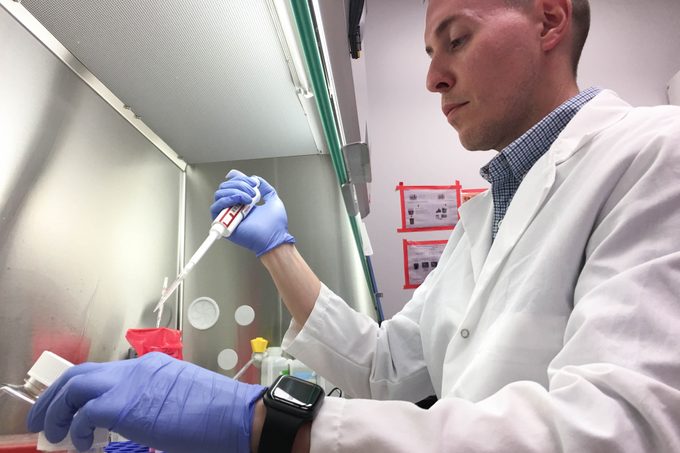I Was Only 23 When I Almost Died of the Flu
Updated: Mar. 11, 2022

Jen Ludwin was 23 when she first came down with the flu. She wasn't too concerned about it, until it nearly cost her life.
When it all began
October 14, 2009 is forever etched into Jen Ludwin’s mind. It’s the day the then 23-year-old, went to the emergency room for a sore throat and what she thought was probably the flu. Doctors sent her home after giving her fluids, but she was back in the emergency room less than 48 hours later.
“I was four weeks into graduate school when I saw something about the H1N1 flu virus making the rounds on the news. I didn’t think much of it, because I had gotten the flu before, and got over it fine,” Ludwin says. This time it felt different. Ludwin’s sore throat progressed to pain in her body, and she had a high temperature and difficulty breathing. (Here’s how to tell the difference between a cold and the flu.)
“I had what I can only describe as organ pain—it wasn’t my muscles or bones, but it felt like my organs were in intense pain. I was vomiting blood and had resorted to wearing a bikini to lay on my kitchen floor just to cool down. When they told me I had something ‘viral’ and to go home and rest, I couldn’t believe it.” At home, Ludwin knew something was terribly wrong. “I’m not a religious person, but that night I said my first prayer. I asked God to let me wake up the next morning.”
A dangerous spiral downward

What happened over the next three days is a blur for Ludwin. “At some point I called my mom, and she could tell I wasn’t breathing well. She threatened to call the paramedics unless I went back to the emergency room, and that’s all that convinced me to go. That’s the last memory I have before waking up in the intensive care unit.”
When she arrived at the hospital, Ludwin was immediately put on oxygen, and it was quickly determined she was already in septic shock and kidney failure. Septic shock is a critical stage of sepsis, which is when an infection causes an immune response that can lead to plummeting blood pressure and a lack of circulation to body organs. Sepsis is a rare but potentially life-threatening complication of the influenza virus, according to Eric Adkins, MD, of Ohio State University Wexner Medical Center in Columbus, Ohio. “Sepsis as a flu complication is thankfully rare, but you can never predict exactly how the body will react to an infectious insult because there are differing levels of activation of the immune system,” he says. “When there’s a lot of inflammation, you’ll see a lot of physiological reactions, such as low platelets, and blood clots impairing the blood flow to fingers and toes.”
Ludwin was immediately put on oxygen, but it wasn’t enough for her weakened lungs. “They had to intubate me and placed me on a ventilator, but even that wasn’t working, so they put me on the last resort—something called an oscillating ventilator. I had to be sedated because they paralyze your body and it physically shakes you. At that point they called my parents to come. When my parents saw the condition I was in they let my siblings know it wasn’t looking good, so they came as well.”
When doctors found that Ludwin was bleeding internally, emergency surgery was scheduled. “I wasn’t expected to survive the surgery, so at that point my parents and extended family came to say goodbye.” Although she survived the risky surgery, the cause of the bleeding was not located. “At the time, I was getting worse, and I developed something called acute respiratory distress syndrome, or ARDS, as well as multiple organ failure and another condition called disseminated intravascular coagulation, or DIC. Most people don’t survive one of those things on their own, and I had them all.”
A chance worth taking

With doctors losing hope that Ludwin would survive her critical state, they tried an experimental flu drug. “My condition finally plateaued,” she said. “It gave doctors the time they needed to begin treating some of the other issues I had.”
There are now four different antiviral medications that can be used to treat the flu, according to the Centers for Disease Control and Prevention. Generally they can help if started within two days of when symptoms start, and they are recommended for those at high risk of flu complications, such as people who are pregnant, have a weakened immune system, or a respiratory or other chronic condition. In general, if a person is otherwise healthy, at relatively low risk of complications, and their flu symptoms are not severe, antiviral medications are not necessary, according to the CDC.
“It really depends on other factors, whether a patient or doctor feel that taking an antiviral is going to be helpful or not. For example, someone with asthma is more likely to be prescribed one to prevent complications like pneumonia, but it typically only shortens the duration of symptoms by a day or so,” says Dr. Adkins. “There are other side effects from the medication as well that some people don’t like. It usually comes down to a discussion with the patient about what they want to do.”
The slow climb to recovery

Ludwin’s body had deteriorated rapidly in a short amount of time. As doctors worked to prevent more damage, she underwent lung and throat surgery. Due to the use of vasopressors (medicines that constrict blood vessels in patients with extremely low blood pressure), she developed clotting in her feet and hands that led to gangrene. “My limbs slowly died. The day before Thanksgiving they deemed me well enough to survive surgery, and they amputated both legs below the knee, all the fingers on my left hand, as well as partial fingers on the right.” To save as much healthy tissue in her hands as possible, doctors created openings near her hips and sewed her hands into her body, removing them every few days to remove more dead tissue. This ensured the remaining tissue of her hands continued to receive a healthy blood supply. “It was this surgery, every few days, to remove my hands, clear the dead tissue, and replace them inside my body, and sew it back up. This went on for four to six weeks.”
Life after near death
Once Ludwin was strong enough to move to a slightly less intensive care level at the hospital, her care team worked to strengthen her enough to begin rehabilitation. “There were more surgeries on my hands, and they worked to wean me off ventilation. I did a lot of physical therapy, since I had been in bed for three months. I weighed 80 pounds. I had to learned to lift my head again, sit up, crawl and walk. I had to relearn everything. I was in rehab for six weeks, and I got my leg prosthetics on Valentine’s Day. I was determined to walk. I just wanted to go home.”
On March 15, 2010, Ludwin was sent home to continue to recover at her parents’ home. Less than a year later, she resumed the life she had before the flu turned her world upside down. “By August I was back in grad school, less than a year later, and fully independent. When I was in the hospital, nurses asked my family for one word that described me, and they all said ‘feisty.’ The nurses said that would be what got me through this—and it did.”
Her new mission
It’s been a decade since Ludwin’s fight for her life began. The 10-year milestone is a big one, and one she never thought she would see. In the past ten years she’s earned two master’s degrees, and plans to return to school for her doctorate. She works full-time in healthcare, and is passionate about educating others about influenza. “If I had taken the flu seriously, maybe this wouldn’t have happened. I know some people say they don’t like needles, and that’s the reason they don’t get the vaccine—but I’d take five seconds of pain over the mental and emotional trauma I’ve endured. This won’t ever go away.” Ludwin says it’s a myth that you can catch the flu from the flu vaccine, and she wants to educate as many about the truth as she can. Here are some other flu myths that are actually true.
Dr. Adkins urges people to practice caution and good hygiene habits during flu season especially. “It’s spread by droplets, so you want to prevent contact with your mucus membranes. Don’t touch your face, and wash your hands. Wear a mask and use hand sanitizer. During this time, maybe opt for a fist bump instead of a handshake, to help reduce transmission.”
A flu shot may be your best protection
As for the flu vaccine, Dr. Adkins encourages everyone to receive one. He stresses that the CDC does its best to ensure that the most virulent strains for the upcoming flu season are included in the vaccine.
“It’s basically someone’s best prediction of the top ten most wanted bad guys. You can only put three or four of their photos in a vaccine, so if your body gets a strain that it hasn’t seen yet, that’s when the immune responses can be varied.” This is what happened with the H1N1 virus the year Ludwin got sick. “That strain was very bad, and we saw many more serious complications,” says Dr. Adkins. (Watch out for these signs that your flu is deadly.)
